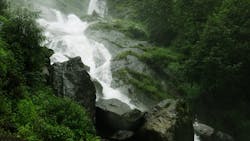Groundwater monitoring with seismic instruments
GERMANY -- Water in the high-mountain regions has many faces. Frozen in the ground, it is like a cement foundation that keeps slopes stable. Glacial ice and snow supply the rivers and thus the foothills with water for drinking and agriculture during the melt season. Intense downpours with flash floods and landslides, on the other hand, pose a life-threatening risk to people in the valleys. The subsoil with its ability to store water therefore plays an existential role in mountainous regions.
But how can we determine how empty or full the soil reservoir is in areas that are difficult to access? Researchers at the German Research Centre for Geosciences (GFZ), together with colleagues from Nepal, have now demonstrated an elegant method to track groundwater dynamics in high mountains: They use seismic waves, such as those generated by ground vibrations, which they record with highly sensitive instruments. Similar to medical ultrasound, they exploit the fact that the waves propagate differently in different subsurface conditions. The researchers led by Luc Illien, Christoph Sens-Schönfelder and Christoff Andermann from GFZ report on this in the journal AGU Advances.
Seismic waves well-known from earthquakes. After a rupture in the subsurface, they propagate rapidly and unleash destructive forces. However, there are also much smaller waves caused, for example, by trucks, streetcars or -- in the mountains -- by falling rock. The ground is actually vibrating all the time. In geoscience, this is referred to as "seismic noise." What has to be laboriously extracted from the measured data of seismometers in earthquake detection turns out to be a valuable source of information when looking into the subsurface. This is because seismic waves propagate differently in the water-saturated zone than in the unsaturated zone, also called vadose zone.
Luc Illien, a PhD student at GFZ, and his colleagues used two Nepalese seismic stations at 1,200 and 2,300 meters above sea level. Luc Illien says: "The Nepalese Himalayas provide vital water resources to a large part of the population of South Asia. Most of this water drains through mountain groundwater reservoirs that we can poorly delineate." The study area comprised the catchment area of a small tributary to the Bothe Koshi, a border river between China and Nepal. Using several weather stations and level gauges, the team collected data, sometimes every minute, over three monsoon seasons. From this, they established a groundwater model that they could compare with the seismic records. The result: runoff to the Bothe Koshi is fed mainly from the deep aquifer. In the dry season, little water flows down the valley. In the monsoon, levels rise, but two distinct phases can be identified. First, it rains without increasing the discharge, but later a clear correlation between rainfall and river level becomes apparent. Christoff Andermann, co-author of the study, explains, "The first rainfall initially replenishes reservoirs in the soil near the surface. Once the soil is saturated with water, the deep groundwater reservoir, which is directly linked to the rivers, fills up. An increase in groundwater is then immediately reflected in rising river water levels."
The comparison with the data from seismometers showed that the saturation of the vadose zone can be well deduced from the seismic noise. "Only by merging the hydrological observations with the seismic measurements we could analyze the function of the vadose zone as a link between precipitation and groundwater reservoir," says Christoph Sens-Schönfelder. First author Luc Illien: "Understanding how the reservoir fills and drains is crucial for assessing its sustainability. From this, we can not only make predictions for runoff, but also warn of increased risk of landslides and flash floods." For example, if the soil is already saturated with water, rainfall will run off more superficially and can carry away slopes. Climate change is exacerbating the situation by contributing to changes in large-scale weather patterns and destabilizing the mountain environment. GFZ Scientific Director Niels Hovius, who contributed to the study, says: "Our work in Nepal and its results show how important it is to monitor numerous influencing factors. These include groundwater storage, changes in land use, land cover and precipitation regimes. Capturing and anticipating such changes will help us better predict the future of freshwater resources and mountain landscapes, especially as glaciers continue to melt."
Credit: Luc Illien/GFZ
